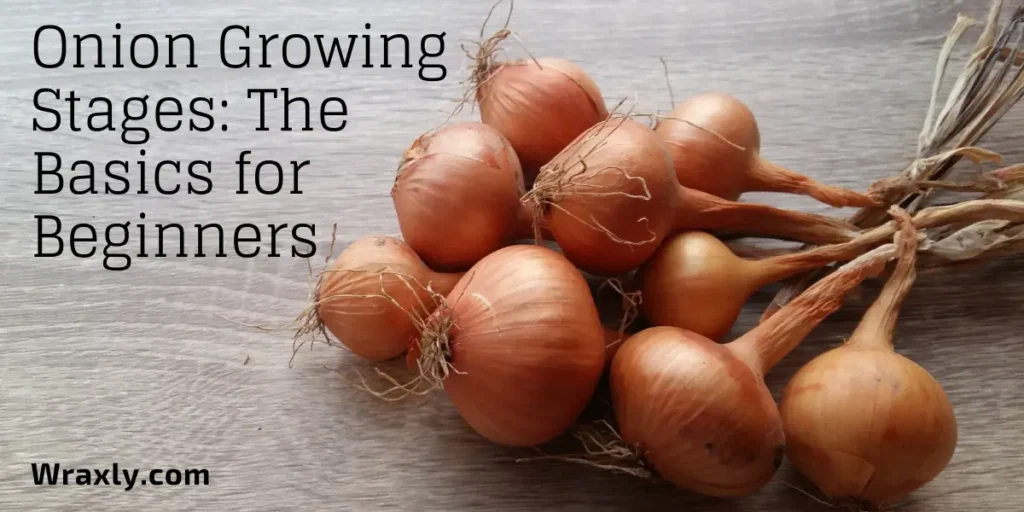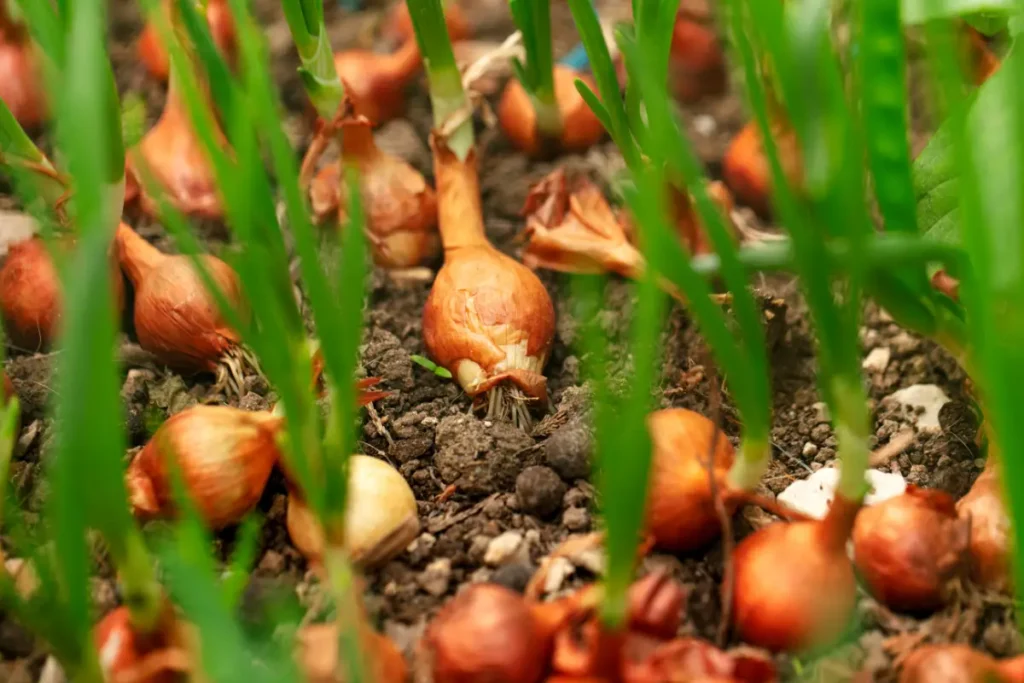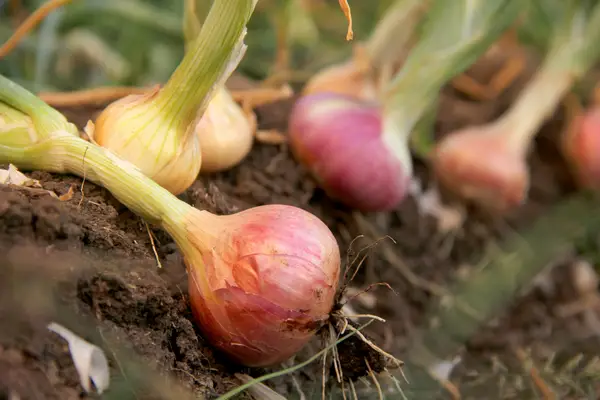Onion is the 4th most consumed vegetable in the US and an inevitable culinary ingredient. 2017 data shows that the per capita onion utilization was 21.9 pounds per person that year. Moreover, the onion industry has grown as the 5th most value-generating sector in the United States.
Given the skyrocketed popularity of onions, you may consider growing them at home. However, learning about the onion growing stages is crucial before you get your hands dirty. Keep reading to learn more about the stages and efficient onion-growing hacks.

Planting
Onions require fertile and well-draining soil and high-quality compost for optimal growth. You can plant the seeds in your garden bed or grow them indoors. Whatever you choose, the ideal time to seed onions is late autumn or spring.
After infusing your soil with high-quality compost, you should plant the onion seeds at least an inch deep. Besides the depth, the spacing also matters. Ideally, you should leave a minimum of half an inch of space between each seed or two feet between each row.
Alternatively to seeds, you can grow onions from sets or transplants. Transplants are seedlings sold in bunches, and you can find them in any random nursery. While they typically form high-quality bulbs quickly, they are also very prone to specific diseases. Thus, buy them carefully.
Sets, on the other hand, refer to under-grown bulbs. You can plant them easily and harvest them earlier. Moreover, they are less likely to catch diseases. However, since these bulbs have been grown in the previous year, they can bolt or form flower stalks very quickly.
To enjoy complete control over this onion growing stage, you should always turn to seeds. Indeed, growing onions from seeds involves more intensive effort and prolonged duration, but it provides you with an extensive alternative to growing them.
Germination
In essence, germination is the anchoring of the seeds with roots that take in nutrients and moisture, allowing the seedling to grow.
Though primarily known as biennial and cool-season plants, onions can be grown as an annual crop. Usually, the seeds germinate during the early seasons as the plant enters the vegetation stage at an optimum temperature range of between 2-15 degrees C.
Generally, germination kicks in within a week. However, it may take longer, depending on the soil temperature. In warm temperatures, onion seeds can germinate within 4-5 days.
Once you notice adequate leaf growth from the seedlings, you should thin them down. Once you finish the thinning job, it’s time to transplant the seedlings, maintaining a gap of approximately four inches. Remember, onion plants usually feature deep roots and require vigorous irrigation during the growing season.

Vegetation
This is the onion growing stage where the onion seedlings develop a robust root system. You might also notice mature leaves around the seedlings at this stage, which multiply until your plants are ready to form bulbs.
Bulb Development
When your plants grow adequate leaves, they start producing bulbs. The already-grown leaves further elongate during the bulk production phase, increasing the area for photosynthesis. Every leaf features a scale, which later becomes the rings. The central storage tissue of the bulb derives from leaf sheaths. You can see the developing bulbs within a few weeks from vegetation.
Typically, the onions start to grow from the ground, forming the bulb on top. Once the bulbs mature, the leaves help to transport the necessary resources to the scales, allowing for optimal bulb growth. Eventually, the bulbs become brown and fluffy, which is when you can harvest them.

Reproduction
If you don’t harvest your onions in the winter, they eventually start reproducing. The plants send up new shoots that gradually appear at the soil surface. When the temperature rises, the plants begin to grow a flowery stalk. At this point, your plants discontinue vegetative growth, preparing themselves for the end of the cycle.
Once the stalks mature, the top of the plant gets covered with purple or white flowers. Bees, butterflies, etc., then pollinate the flower heads which contain seeds. Once the seed shows up, your plant completes its life cycle.
Growing Healthy Onions – 6 Vital Hacks
Indeed, growing onions is one of the most straightforward jobs in the gardening verse. However, it’s not limited to poking a hole into the ground and stuffing the seeds. There are a few tricks that you need to follow to ensure the healthy growth of your onions throughout the different onion growing stages.
1) Preparing Soil
Did you know the flavorsomeness of onions depends on how you nurture them? If you are trying to grow sweet onions like Walla Walla or Texas Sweet, you need to be extremely careful with the pH ranges of the soil. The ideal pH level for growing onions is anything between 6.0 to 6.8.
Ideally, you should get your soil tested for pH, and if the levels are not optimal (anything less than 6.0), consider applying dolomitic lime for the next 2-3 months. After three months, go for another soil test; if the pH level crosses the mark of 6.0, proceed with soil preparation. Checking the pH levels is crucial, as low ones may lead to nutrient deficiency.
If growing onions on raised beds, be careful while mounding up the soil. Ideally, you should fill the raised bed with a soil type designed to support the texture and weight of the beds. You will want to maintain at least six inches of depth so that your plant’s roots can remain well-covered.
2) Composting
Onions grow best in loose and loamy soil. Thus, you should infuse it with well-rotted compost. Remember, infusing the prepared soil with composted manure contributes to the value of the soil’s organic matter. Most importantly, adding organic compost ensures better moisture retention.
Ensure that the compost is evening distributed throughout your soil.
3) Watering
Onion roots can’t absorb water or moisture efficiently. Hence, they require an uninterrupted water supply for healthy growth. However, once the bulbs enlarge, you should stop watering your plants.
4) Thinning
Most nourished bulbs come from seedlings with pencil-like diameters. Therefore, be careful when thinning your seedlings. Ideally, you should keep the largest seedlings together to grow extra juicy, full-sized onions.
5) Emergency Care
Onion leaves are pretty prone to little black onion thrips. These thrips absorb sap from the leaves, so you may not notice them right away as they typically sit on the neck of the leaves. Moreover, onion plants can become the victim of aphids and root maggots.
Look for these intruders, as they can harm your plant severely. See: Organic Pest Control
6) Harvesting
Onions can be harvested at various stages. For example, if you like spring onions, you can harvest them within a few weeks of planting. On the other hand, if you prefer fully grown bulbs, you will have to wait a little longer. When the bulb turns big, and their tops become yellow, they are ready for harvesting.
You just need to pull the bulbs up, clean the soil, and cure them. Summer is the best season for harvesting onions, as bulbs don’t like excessive moisture or water. If they are rained upon, they will rot. Therefore, once you are done harvesting, it’s time to store them in a cool, dry place. If you keep your onions in refrigerators, wrap them well in paper towels to prevent moisture-induced damage.
Recommended Onion Seeds
Frequently Asked Questions
Generally, onions take up to 80 days to grow from the set. However, the duration may vary depending on the type of onion and the temperature.
Onions require adequate nitrogen for optimal growth. Therefore, you should use a fertilizer that contains ammonium nitrate or ammonium sulfate. Add one cup for every 20 feet for the best results. In addition, maintain a 3-week gap when reapplying the fertilizer.
Onions require adequate nitrogen for optimal growth. Therefore, you should use a fertilizer that contains ammonium nitrate or ammonium sulfate. Add one cup for every 20 feet for the best results. In addition, maintain a 3-week gap when reapplying the fertilizer.
When the bulbs of your onions turn big, and their tops become yellow, they are ready to harvest. However, if you like spring onions, you shouldn’t wait for the bulbs to grow. Instead, you should cut them within a few weeks after planting the seeds.
For Further Reading
- Is Onion a Vegetable?
- How to Grow Onions in a Grow Bag
- The Surprising Truth About Garlic: Is it Really a Vegetable?
Final Thoughts on Onion Growing Stages
To conclude, onions are one of the most excellent vegetables to grow at home. You can grow them in gardens or indoors. However, handle your plants carefully, water them frequently, and save them from maggots and other parasites. Furthermore, use appropriate fertilizer to ensure healthy growth. Follow the shared suggestions to grow sweet and juicy onions at home. Good luck!

Darrell has a passion for gardening that he inherited from his father. Go here to read more about the influence his father played in his love for gardening. If you want to send Darrell a quick message, then visit his contact page here.

![How to Water Indoor Plants [Plant Care 101]](https://wraxly.com/wp-content/uploads/2021/03/How-to-Water-Indoor-Plants-Plant-Care-101-1200-1024x576.webp)

![Growing Plants from Cuttings [A Simple Guide]](https://wraxly.com/wp-content/uploads/2021/03/Growing-Plants-from-Cuttings-A-Simple-Guide-1200-1024x576.webp)